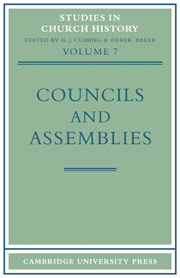Book contents
- Frontmatter
- Preface
- Contents
- Contributors
- Abbreviations
- Public welfare and social legislation in the early medieval councils (Presidential Address)
- National synods, kingship as office, and royal anointing: an early medieval syndrome
- The case of Berengar of Tours
- Ecclesiastica and Regalia: Papal investiture policy from the Council of Guastalla to the First Lateran Council, 1106–23
- Viri religiosi and the York election dispute
- Councils and synods in thirteenth-century Castile and Aragon
- The Byzantine reaction to the Second Council of Lyons, 1274
- The Council of London of 1342
- Education in English ecclesiastical legislation of the later Middle Ages
- The representation of the universitas fidelium in the councils of the conciliar period
- Nicholas Ryssheton and the Council of Pisa, 1409
- The condemnation of John Wyclif at the Council of Constance
- Some aspects of English representation at the Council of Basle
- The Council of Basle and the Second Vatican Council
- The Colloquies between Catholics and Protestants, 1539–41
- King James I's call for an ecumenical council
- John Hales and the Synod of Dort
- Assembly and Association in Dissent, 1689–1831
- The Convocation of 1710: an Anglican attempt at counter-revolution
- Laymen in synod: an aspect of the beginnings of synodical government in South Africa
- The First Vatican Council
- Kikuyu and Edinburgh: the interaction of attitudes to two conferences
The condemnation of John Wyclif at the Council of Constance
Published online by Cambridge University Press: 12 March 2010
- Frontmatter
- Preface
- Contents
- Contributors
- Abbreviations
- Public welfare and social legislation in the early medieval councils (Presidential Address)
- National synods, kingship as office, and royal anointing: an early medieval syndrome
- The case of Berengar of Tours
- Ecclesiastica and Regalia: Papal investiture policy from the Council of Guastalla to the First Lateran Council, 1106–23
- Viri religiosi and the York election dispute
- Councils and synods in thirteenth-century Castile and Aragon
- The Byzantine reaction to the Second Council of Lyons, 1274
- The Council of London of 1342
- Education in English ecclesiastical legislation of the later Middle Ages
- The representation of the universitas fidelium in the councils of the conciliar period
- Nicholas Ryssheton and the Council of Pisa, 1409
- The condemnation of John Wyclif at the Council of Constance
- Some aspects of English representation at the Council of Basle
- The Council of Basle and the Second Vatican Council
- The Colloquies between Catholics and Protestants, 1539–41
- King James I's call for an ecumenical council
- John Hales and the Synod of Dort
- Assembly and Association in Dissent, 1689–1831
- The Convocation of 1710: an Anglican attempt at counter-revolution
- Laymen in synod: an aspect of the beginnings of synodical government in South Africa
- The First Vatican Council
- Kikuyu and Edinburgh: the interaction of attitudes to two conferences
Summary
The Council of Constance was perhaps the most dramatic of all the ecumenical councils of the Church. Called under stress by an anti-pope whom it proceeded to depose, it was the scene of the fire that burned John Hus and the arena for the debate of the most potent political theories of the time. It was fitting that it should be an occasion for the condemnation of the works of John Wyclif, the firebrand heretic of the preceding century.
Consideration of Wyclif's condemnation at Constance is usually overshadowed by the condemnation of John Hus, of which process the action concerning Wyclif was a part. However, for the purposes of this paper, the focus will be placed on the total condemnation process of the two men specifically insofar as it concerns Wyclif. When this is done, an interesting succession of events at the Council emerges from the general mass of its records.
Wyclif, of course, had died as the result of a stroke in 1384. He had at that time already been condemned as heretical by Pope Gregory XI, who in 1377 had extracted nineteen erroneous conclusions from Wyclif's treatise De Civili Dominio, I. There would seem to have been little point in raising him for new condemnation at Constance if there had not been some contemporary representation of his ideas. This was seen in John Hus.
Thus the story of Wyclif at Constance begins with the early arrival of Hus at the Council. Hus was convinced of his own innocence of heresy, but realized that he might be in some danger.
- Type
- Chapter
- Information
- Councils and Assemblies , pp. 209 - 218Publisher: Cambridge University PressPrint publication year: 1970
- 1
- Cited by



